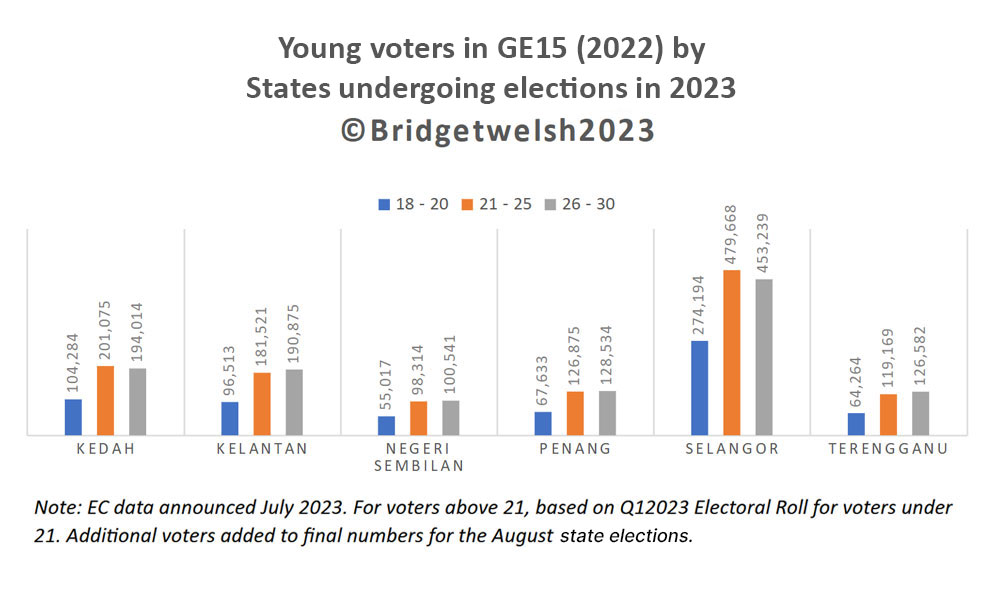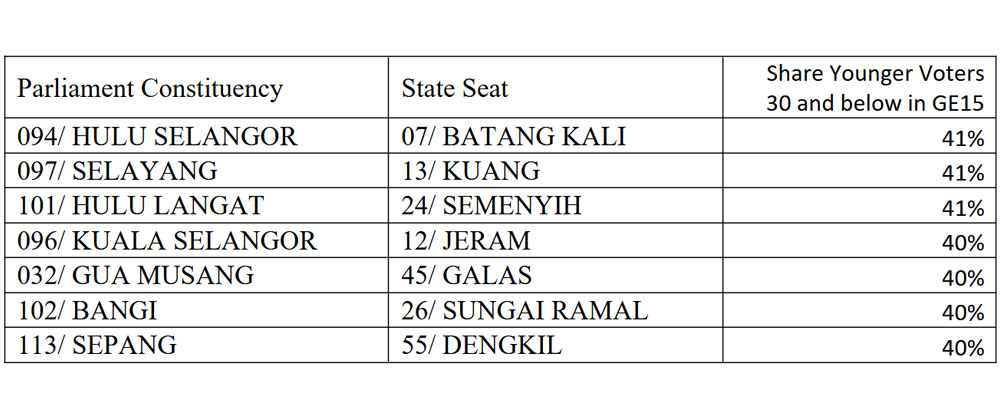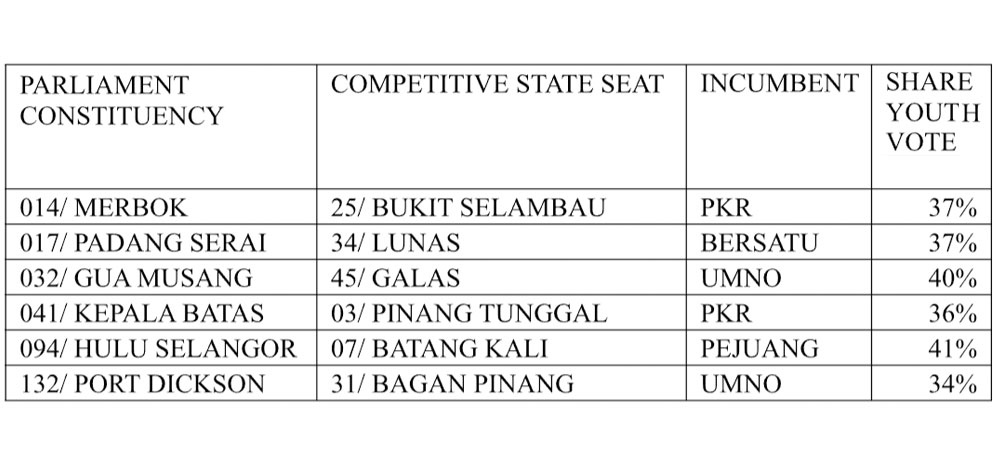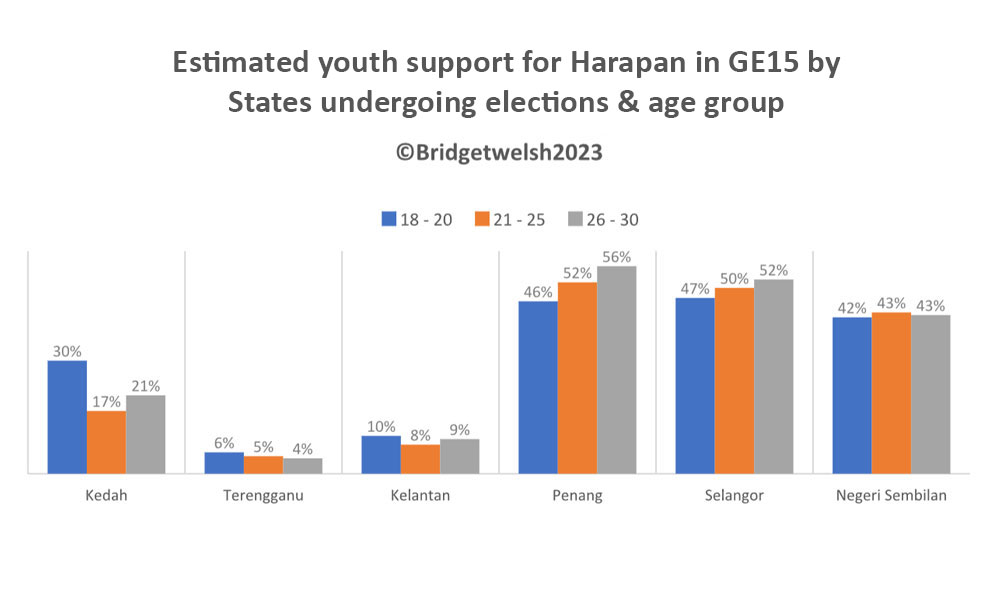Younger Malaysians have regularly made each election a different, more competitive campaign.
This was especially the case in the 15th general election (GE15) when the voting age was lowered and automatic registration brought in voters who had opted not to register - disproportionately voters in their 20s.
In these coming state polls, younger voters will also be decisive in shaping the outcome.
It is also something political parties understand. Politicians are already exchanging words about the youth vote, ironically claiming it while not actually engaging youths directly or with issues that impact them.
Understanding youth voting
This fourth piece in my state elections series for Malaysiakini focuses on how the youth will be shaping the coming state campaigns.
For my analysis, I use polling station data and the electoral roll in different saluran undi (polling streams) to make statistical estimates on voting patterns, as well as develop potential scenarios to look at the impact of youth – voters under 30 – swings.
This piece extends Malaysiakini’s NewsLab feature on youth voters which provides an important preliminary overview of differences across generations using saluran data from polling stations.
Its particular strength is the visual differences in youth voting and details of differences by generation at the constituency level.
My methodology differs as I use the actual average age of voters in different streams and the results to make estimates on voting using ecological inference, rather than relying exclusively on the reported results by different streams.
When I pioneered the use of saluran data results only for generation analysis back in 2014, I recognised that caution should always be taken when using this descriptive method, as different saluran capture when voters were registered, not their ages.
Also, there needs to be enough different saluran to measure difference (which is not always the case in less voter-populated areas).
The caution has increased from the 2022 Johor state polls and in GE15, as the reliability of using saluran data for generation analysis in GE15 has been reduced considerably due to automatic voter registration.
Now, the lower saluran capture voters from all age groups in the past election, and depending on who was brought into the electoral roll.
As such, the ecological inference method provides comparatively more accuracy in measurement, with its own limitations as only a statistical estimate.
Increasing youth numbers
To start, let’s look at youth voters. Between November 2022 and April this year, an estimate of over 400,000 younger voters were added to the electoral roll nationally.
This comes after 5.8 million young voters were added nationally for GE15 in 2022. Disproportionately, these younger voters are Malay and concentrated in the most populous states of Selangor and Johor.
Given this demographic-driven trend and wider enfranchisement, young voters will impact all of the six states in the coming elections. This was the case in GE15 as well.
Youth power begins from their numbers. Based on the GE15 electoral roll, Selangor had the most young voters, followed by Kedah and Kelantan.
By January this year, over 200,000 voters were added to the electoral roll, most of these 18-20 years old. In Selangor, this number reached over 70,000 new voters, while Negeri Sembilan added 13,000 new voters.
As Malaysia is a young population, these numbers will continue to increase. Steadily, each state has more youth who can vote, as the balance of power moves from older Malaysia towards its future.

Influence not just numbers
What makes these youth voters important in these state contests is not just their numbers.
First, what matters is their share of the overall electorate. In the six states facing election, younger voters comprise an average of 30 percent of the votes. They are the highest share in Kelantan and Terengganu.
Those in their 20s (21-25 years, 26-30 years) are double that of the youngest voters, 18-20 years.

As Malaysian constituencies are highly malapportioned, some with small numbers of voters, younger voters make up even larger shares of the vote in some constituencies.
There are seven state constituencies where younger voters comprise 40 percent (or over) of the vote share.

It is important to appreciate that state constituencies have considerably smaller numbers of voters, except those in Selangor, so even small swings among youth can impact electoral outcomes.
Youth are political movers
Beyond composition, younger voters are where the action is (or isn’t). The second factor that makes them electorally important is that they are disproportionately more politically undecided and simultaneously more likely to change their vote.
In part, this is because many young people are less engaged politically, and are less politically literate. They also do not have strong party loyalties and have been socialised at a time when changing one’s political support is more common.
As such, none of the parties should be taking the youths for granted. Youths are diverse and should not be seen as a cohesive unit. The challenge is that many youths feel they are not seen at all.
Youths should not be underestimated in their awareness and frustrations. In fact, the more overconfident parties are in youth support, the less likely they are to reap the support they expect from the youth.
Youths are the ground that needs to be won over, although political parties seem to have not fully appreciated this.
Winning younger voters is not just a token RM200 eBelia distribution, but meaningful engagement and respect. The overwhelming issue of concern for younger voters is the economy.
Yet youth are concerned about the present and future, with different mindsets from outdated leaders. Compared to older cohorts, younger Malaysians are also not as hung up on the racist vitriol of older generations, who continue to stoke division.
There is growing dissatisfaction among youths with politics in general, especially older youths in their late 20s who are fed up with parties across the political divisions.
Equally impactful is that many youths have yet to decide whether they will vote. The youth turned out in high numbers in 2022. Yet previous patterns of turnout among younger voters in state elections show the young turn out the least in these types of elections.
State elections are not seen as important as GE15 among the youth. Disproportionately, youth comprise the majority of outstation voters, especially in locations with limited economic opportunities as is the case in Kedah and Kelantan.
Many youths have to assess whether it is worth voting in terms of financial and time costs. Youths have opted not to return in the recent past. In GE15, many Kelantanese younger voters did not return to vote, contributing to the lowest turnout among younger voters in Peninsular Malaysia.
The (mistaken) sentiment that their vote would not impact the results was reinforced by the limited engagement of youth by parties in Kelantan.
In the coming state elections, with a ‘status quo’ view of the potential results dominant, younger voters may similarly be less inclined to return, especially as many lack the funds to return due to the still not yet recovered economy.
This may change as the campaign heats up. Better machinery and resources contribute to bringing youth voters back, but the campaigns have gotten off to a comparatively slow start in engaging voters directly.
In fact, overall, the quality of political engagement with youth has been limited.
Power of youth vote
Turnout, in particular youth turnout, will impact the outcome of the results, as many contests are competitive.
In my study of the 245 state seats to be contested across the six states this August, I have assessed 105 as competitive (in varying levels based on scenarios and local conditions. Note this number will shift after nomination day).
The majority of competitive seats are in Kedah and Selangor. Youth will be especially important in these potential close contests.
To understand the power of youth, one needs to look at whether changes in youth turnout and support will influence the outcome.
Of the competitive seats based on my pre-nomination scenario analysis, more than half of these can be influenced by a decisive swing in support toward a party/candidate by youth.
In a quarter of these, even a modest swing among youth voters will shape the outcome, based on scenario simulations.
Here are some examples:
Based on my analysis of voting trends and potential trends among younger voters in GE15, each of these illustrative seats risks being lost to the incumbent party even with a modest 10 percent swing in support and a conservative modest drop in support of seven percent.
Of these competitive seats, Galas is the most vulnerable to a youth swing, while Bagan Pinang is the least. Although the levels of competitiveness will not be finalised until nomination day when candidates and parties contesting are finalised, the realities of youth electoral power are real.

In my earlier assessment of generation voting in GE15, there were two distinct electoral support patterns among the youth.
In Kedah, Kelantan, and Terengganu, the overwhelming majority of youth voted for PAS/Perikatan Nasional (estimated 64 percent, 66 percent, and 66 percent respectively.)
While in Harapan-governed states, only a small share of youth voted for PAS/PN, estimated at 34 percent in Penang and Selangor and 29 percent in Negeri Sembilan, with the majority voting for Harapan.

These coming state elections will test whether young people maintain these loyalties. If previous elections are an indication, expect patterns to change. Also expect that if change happens (or does not happen) in the outcome, youth will be the ones driving it.- Mkini
BRIDGET WELSH is an honorary research associate of the University of Nottingham, Malaysia’s Asia Research Institute. She is also a senior research associate at the Hu Fu Centre for East Asia Democratic Studies and a senior associate fellow at The Habibie Centre. Her writings can be found at bridgetwelsh.com.
The views expressed here are those of the author/contributor and do not necessarily represent the views of MMKtT.




No comments:
Post a Comment
Note: Only a member of this blog may post a comment.